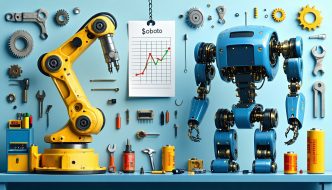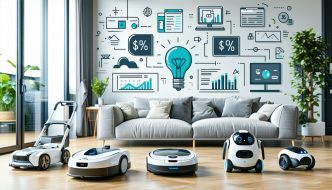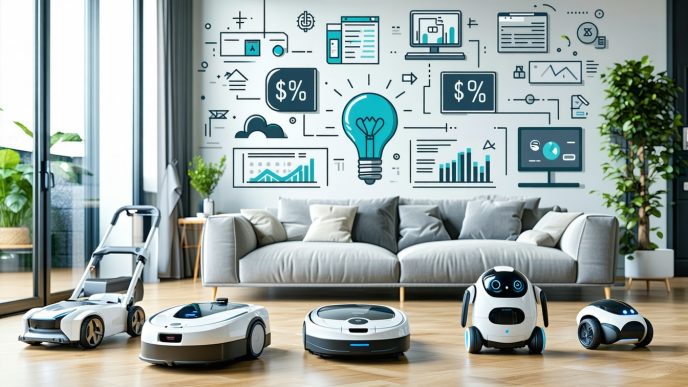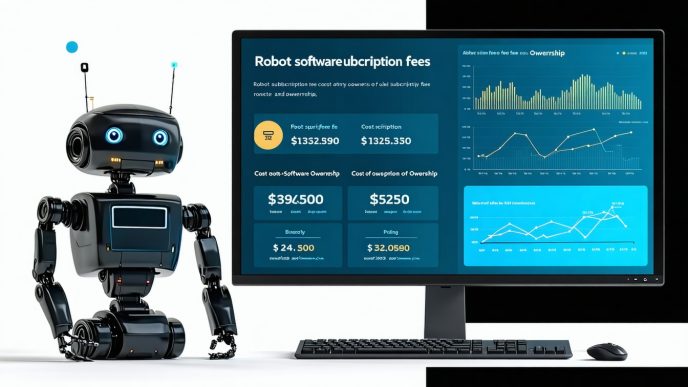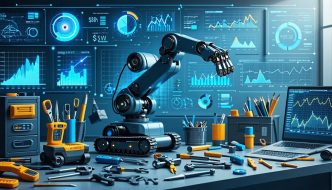Understanding Robot Maintenance
Maintaining robots effectively is essential for ensuring their longevity and optimal performance. Understanding the nuances of robot maintenance can help buyers anticipate costs associated with repairs and replacements, allowing for informed investment decisions.
Importance of Regular Maintenance
Regular maintenance is vital for maximizing a robot’s efficiency and lifespan. Routine check-ups and servicing can identify potential issues before they escalate into costly repairs. By keeping up with maintenance, users can ensure their robots operate at peak performance, thereby minimizing the risk of unexpected breakdowns.
Benefits of regular maintenance include:
- Prolonged device lifespan
- Improved efficiency and performance
- Reduced risk of costly repairs
- Enhanced safety during operation
Investing in regular maintenance ultimately assists users in controlling their long-term robot repair and part replacement expenses.
Typical Lifespan of Robot Parts
Each component of a robot has a different lifespan, which varies based on usage, care, and the environment in which it operates. Understanding these timelines can help users plan for future expenses and maintenance.
| Robot Part | Average Lifespan (Years) | Replacement Cost (Estimation) |
|---|---|---|
| Battery | 2-4 | $100 – $300 |
| Motors | 3-5 | $150 – $400 |
| Sensors | 4-6 | $50 – $150 |
| Wheels/Casters | 5-7 | $20 – $60 |
| Circuit Boards | 5-10 | $100 – $250 |
Being aware of the right time to replace these components can help users manage their long-term cost of ownership for home robots. Additionally, understanding these lifespans allows for better budgeting for maintenance and repairs.
Considering the lifespan of robot parts is a critical component of predicting overall costs. For more insights into managing these expenses effectively, refer to our guide on hidden costs in robot ownership.
Signs of Wear and Tear
Understanding the signs of wear and tear is crucial for maintaining the longevity of robots. Recognizing these signs early can prevent larger issues and reduce overall robot repair and part replacement expenses.
Common Signs of Parts Wearing Out
Several indicators can suggest that parts of a robot are beginning to wear out. Being aware of these signs can help owners take proactive measures:
| Sign | Description |
|---|---|
| Reduced Performance | The robot may become slower or less effective in completing tasks. |
| Noises | Unusual sounds, such as grinding or clicking, may indicate mechanical issues. |
| Physical Damage | Visible cracks, breaks, or loose components can suggest wear. |
| Malfunctions | Frequent errors or failure to execute commands may signal deteriorating parts. |
| Battery Issues | Shorter usage times or failure to hold a charge can indicate battery wear. |
Monitoring these signs helps in planning maintenance or repairs more efficiently. For more details on expenses related to maintaining robots, see our article on robot maintenance costs.
Effects of Neglecting Maintenance
Neglecting regular maintenance can lead to a cascade of issues, potentially escalating costs related to repairs and replacements. The impact can be significant:
| Effect | Description |
|---|---|
| Increased Repair Costs | Small issues can become major problems, leading to higher expenses. |
| Shortened Device Lifespan | Failure to maintain can result in further degradation and earlier replacement needs. |
| Performance Decrease | A neglected robot will struggle to perform optimally, leading to disappointment and dissatisfaction. |
| Safety Risks | Worn-out parts may pose safety hazards for users, especially in automated environments. |
| Decreased Efficiency | Failure to address wear can cause the robot to work harder, increasing energy consumption. |
Understanding these effects emphasizes the importance of regular upkeep as part of the overall cost of ownership for home robots. For more insights into overall robot ownership expenses, check our guide on hidden costs in robot ownership.
Cost Considerations
Understanding the financial implications of owning a robot goes beyond the initial purchase price. Evaluating robot repair and part replacement expenses, along with ongoing maintenance, provides a clearer picture of the total cost of ownership.
Factors Affecting Repair Costs
Several factors influence the costs associated with repairing a robot. These include the type of repair needed, the specific parts that are worn or broken, and whether the repair is performed by a professional or carried out as a DIY project. Below is a table highlighting common factors that affect repair costs:
| Factor | Description |
|---|---|
| Type of Repair | Major repairs often cost more than minor fixes. |
| Parts Availability | Rare or specialized parts can increase repair costs significantly. |
| Labor Costs | Professional services typically come with labor fees. |
| DIY Capability | Skill level affects whether one can save on labor costs. |
| Warranty Status | Repairs on devices under warranty may incur little to no cost. |
Understanding the variability in these costs can assist potential buyers in planning for future expenses. For more detailed insights on these expenses, one can refer to our article on robot maintenance costs.
Comparison with Replacement Costs
When faced with a malfunctioning robot, owners often weigh the cost of repairs against the expense of replacement. To facilitate this decision, below is a comparison table showcasing common repair costs versus average replacement costs:
| Type of Common Repair | Average Repair Cost | Average Replacement Cost |
|---|---|---|
| Battery Replacement | $50 – $150 | $300 – $1000 |
| Motor Replacement | $100 – $300 | $300 – $1200 |
| Software Issues | $30 – $100 | $300 – $1000 |
| Sensor Replacement | $40 – $200 | $300 – $1500 |
Assessing repair costs against replacement costs helps buyers make informed decisions about maintaining versus replacing their robots. For additional context on ongoing expenses, consider reviewing our article on hidden costs in robot ownership.
By comprehensively understanding robot repair and part replacement expenses, individuals can better navigate their investment in robotic technology, ensuring that they make choices aligned with their budget and long-term needs.
DIY vs. Professional Repairs
When it comes to maintaining and repairing robots, the choice between DIY (do-it-yourself) and hiring professionals can significantly impact both cost and effectiveness. Each approach has its own benefits and drawbacks that are important for first-time buyers, value-conscious shoppers, and tech enthusiasts to consider.
Benefits of DIY Repairs
Opting for DIY repairs can present several advantages, particularly for those who are comfortable with technology and enjoy hands-on projects.
- Cost Savings: The most notable benefit of DIY repairs is the potential for substantial cost savings. By performing repairs themselves, individuals can avoid labor costs associated with professional services.
- Learning Experience: Undertaking repairs can be a valuable learning opportunity. Users can gain insights about their robot’s functionality, enhancing their understanding and ability to troubleshoot in the future.
- Convenience: DIY repairs allow individuals to work on their robots at their own convenience without needing to schedule an appointment with a professional. This can lead to quicker resolution of issues.
- Access to Resources: Many repair guides and online communities provide resources and advice for DIY repairs, making it easier for users to find solutions to common problems.
A comparison of potential costs between DIY and professional repairs is illustrated in the table below:
| Repair Type | Estimated Cost |
|---|---|
| DIY Repairs | $10 – $50 (parts only) |
| Professional Repairs | $75 – $200 (labor + parts) |
Advantages of Professional Repairs
Professional repairs offer certain benefits that may outweigh those of DIY, especially for individuals who may not have the necessary skills or time to perform repairs themselves.
- Expertise and Experience: Professionals have specialized training and experience, which can lead to more effective repairs. This is particularly important for complex issues that require detailed knowledge of the robot.
- Guaranteed Work: Many professional services offer warranties on their repairs, meaning if issues arise post-service, they may fix them at no additional cost. This adds a level of security that DIY often lacks.
- Time Efficiency: Hiring a professional can save individuals valuable time. For busy lifestyles, the convenience of having repairs done quickly and effectively can be a significant advantage.
- Quality Assurance: Professional technicians typically follow best practices and use quality parts, ensuring that the repairs meet a certain standard. This can enhance the longevity and performance of the robot.
For individuals trying to determine the best route while considering their budget, understanding the trade-offs between DIY and professional repairs is essential. Evaluating the potential robot repair and part replacement expenses can help guide decisions on maintenance strategies and financial planning moving forward.
By balancing the benefits of both DIY and professional services, first-time buyers and value-conscious shoppers can better navigate the costs associated with robot ownership and care. For more information on overall ownership costs, visit our article on cost of ownership for home robots.
Planning for Unexpected Expenses
Understanding the potential expenses associated with robot ownership is crucial for first-time buyers and value-conscious shoppers. Proper planning ensures that they can manage the cost of repairs and replacements effectively.
Budgeting for Repairs and Replacements
A well-prepared buyer anticipates potential robot repair and part replacement expenses. A typical budget should include considerations for regular maintenance and unexpected repairs. Below is a summary of common repair costs associated with robot ownership:
| Part | Average Repair Cost ($) | Average Replacement Cost ($) |
|---|---|---|
| Battery | 50 – 150 | 100 – 300 |
| Wheels | 20 – 50 | 40 – 100 |
| Sensors | 30 – 100 | 60 – 200 |
| Brushes | 10 – 30 | 20 – 50 |
| Software Issues | 15 – 70 | 30 – 100 |
Robots with more complex features, such as advanced sensors or smart capabilities, may incur higher repair costs. Regular budgeting for robot maintenance costs helps mitigate the impact of unexpected repairs on overall finances.
Warranty Coverage and Extended Plans
Purchasing a robot typically includes a standard warranty that covers specific repairs and replacements for a designated period. It is essential for buyers to familiarize themselves with the terms of the warranty, including what is and isn’t covered.
Many manufacturers offer extended warranties, which may provide additional coverage beyond the standard terms. These plans can be beneficial, particularly for high-investment models. Buyers should consider the following points when evaluating warranty and extended plan options:
- Standard Warranty: Often covers manufacturing defects and limited parts for 1-2 years.
- Extended Plans: Can add coverage for up to 5 years, sometimes including accidental damage.
- Cost of Extended Plans: Typically ranges from 10% to 30% of the original purchase price.
Buyers should discuss warranty options in detail and evaluate any potential hidden costs in robot ownership associated with repairs outside of warranty parameters. Understanding warranty coverage will help mitigate the financial burden of battery replacement costs for robots and other key expenditures.
In summary, planning for unexpected expenses related to robot ownership involves budgeting for repairs and assessing warranty coverage, allowing for better financial management over time. To ensure comprehensive financial planning, buyers can also explore saving money on robot ownership insights to maximize their investment.
Extending the Life of Your Robot
Investing in a robot goes beyond the initial purchase price; understanding robot repair and part replacement expenses is crucial. Taking care of the robot and ensuring longevity can significantly influence overall ownership costs. Here, some practical tips and strategies for extending the lifespan of a robot are presented.
Tips for Prolonging Robot Lifespan
-
Regular Maintenance: Establish a routine maintenance schedule to check and clean components. This includes checking sensors, wheels, and brushes to ensure they are free from debris.
-
Battery Care: Pay attention to the battery’s condition and performance. Proper charging habits can prolong battery life. Avoid completely discharging the battery when possible. For information on this topic, see our article on battery replacement costs for robots.
-
Use Appropriate Settings: Ensure settings match the environment and cleaning needs. Using a robot in a heavily carpeted area might require different settings compared to hardwood floors.
-
Store Properly: When not in use, store the robot in a dry and safe location. Keeping it away from moisture can help prevent damage.
-
Software Updates: Regularly update the robot’s software to ensure optimal performance. New updates can fix bugs and enhance function.
| Maintenance Activity | Frequency | Impact on Lifespan |
|---|---|---|
| Cleaning Sensors and Brushes | Monthly | High |
| Checking Battery Condition | Every 3 months | Medium |
| Software Updates | As needed | Medium |
| General Maintenance Checks | Biannually | High |
Maximizing Efficiency to Minimize Wear
Maximizing a robot’s efficiency not only helps in completing tasks more effectively but also reduces wear and tear, which in turn impacts long-term ownership costs.
-
Choose the Right Robot: Select a robot that fits the specific needs of the household or workspace to avoid unnecessary strain on the unit.
-
Optimal Charging Practices: Overcharging can reduce battery lifespan. Follow manufacturer recommendations for charging cycles, as highlighted in our article on hidden costs in robot ownership.
-
Usage Patterns: Operating the robot during off-peak hours can reduce energy costs associated with running home robots. For more information on energy efficiency, visit our article on energy costs of running home robots.
-
Avoiding Obstacles: Regularly clearing the area where the robot operates can reduce the risk of mechanical issues and prolong its effectiveness.
-
Keeping it Clean: A clean robot operates better; ensure that dust and debris do not interfere with its operation. Regular external cleaning is recommended to enhance performance.
| Efficiency Strategy | Benefit | Impact on Costs |
|---|---|---|
| Using Appropriate Settings | Reduces stress on components | Lowers repair and replacement exp. |
| Charging according to guidelines | Prolongs battery life | Saves on total ownership costs |
| Regularly clearing workspace | Reduces mechanical failure | Decreases repair frequency |
By implementing the above strategies, robot owners can effectively extend the life of their robots, minimizing future repair and replacement expenses. For insights on budgeting for these costs, refer to our article on cost of ownership for home robots.

